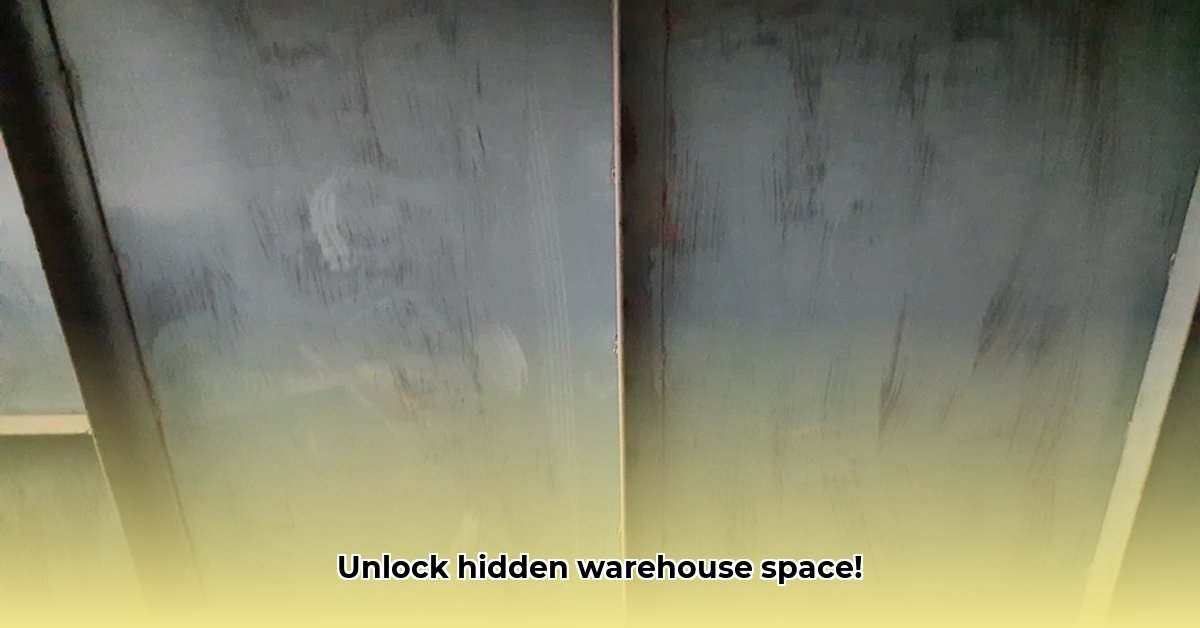Running out of room in your warehouse? A prefabricated mezzanine floor could be your answer. These systems turn wasted vertical space into usable areas. This guide cuts through the confusion, helping you avoid costly errors and find the perfect fit for your business. We’ll cover everything from smart design choices to long-term maintenance, so you can make the most of your investment and boost your warehouse efficiency. We’ll even compare different systems to help you decide which is best for you. For more information on warehouse mezzanine options, check out this [helpful guide](https://www.wavesold.com/mezzanine-floor-for-warehouse).
Prefabricated Mezzanine Floor Systems: Making the Most of Your Warehouse Space
So, you’re looking to squeeze more out of your warehouse? Running out of room is a common problem, but a prefabricated mezzanine floor system might be the perfect solution. Think of it as adding another floor to your warehouse – but without the massive construction project and hefty price tag. These systems are built off-site in sections, then assembled on location, like a giant, super-strong Lego set. This means less disruption to your daily operations. What are your current operational bottlenecks related to warehouse space? Consider how a mezzanine could alleviate these issues.
Before you dive into the specifics, let’s figure out what you really need. How much stuff are you storing, and what is its weight profile? Are we talking heavy machinery, lightweight boxes, or a mix? This determines the strength and build of the mezzanine you’ll need. Think about your workflow, too. Will the mezzanine help separate different product types, improve the flow of goods, or create dedicated kitting or assembly areas? Your answers will help you nail down the ideal system.
Need specialized features? Some systems offer customized flooring to suit different uses – from anti-slip surfaces to static-dissipative options. Height adjustments are crucial for accommodating varying equipment and personnel. Integrated lighting and climate control systems further enhance the usability of your new space. Look for systems that can adapt to your specific needs. In fact, most prefabricated mezzanine floor systems should exceed 245 lbs per square foot, so be sure to ascertain the capacity of the option you are considering.
Here are some key considerations:
- Space Optimization: Prefabricated mezzanines efficiently utilize vertical warehouse space.
- Customization: Systems offer adaptable features like flooring, height, and lighting.
- Workflow Improvement: Strategic design enhances product flow and separation.
Let’s compare some top contenders in the prefabricated mezzanine market. Think of it like comparing vehicles – some are workhorses, others are designed for precision, and each has its place. We’ll look closer at two well-known brands: Heinrich Brothers and Mezzanines Online. Both are established players known for meeting high safety and load capacity standards (generally exceeding 245 lbs per square foot). But, they’ve carved out their niches in slightly different ways.
Heinrich Brothers emphasizes cost-effectiveness and fast assembly, making them a strong choice for businesses needing a quick solution. Mezzanines Online emphasizes design and aesthetics providing customizable solutions.
| Feature | Heinrich Brothers | Mezzanines Online |
|---|---|---|
| Load Capacity | Over 245 lbs per square foot | Over 245 lbs per square foot |
| Customization Options | High; lots of choices for flooring, size, height | High; easily adaptable sizes, telescopic systems |
| Installation Time | Fast installation is a major selling point | Speed not specifically emphasized |
| Material Focus | Focuses on cost-effectiveness and fast assembly | High emphasis on design and aesthetics |
| Main Advantage | Quick and budget-friendly | Design and flexible solutions. |
Now, let’s talk installation. Even though both companies design for relatively easy assembly, professional installation is a must. Safety is paramount, and a professional ensures everything is built correctly and securely, meeting all local building codes. This is not a DIY project – you want to make sure that your new mezzanine is safe and sturdy. Securing professional installation ensures structural integrity and adherence to building codes. Failing to follow best practices increases potential for accidents.
Choosing the right system isn’t just about picking the cheapest option; it’s about finding the best fit for your specific needs. If speed and budget are your top priorities, Heinrich Brothers might be your best bet. They generally focus on making installation quick and affordable. However, if you prioritize design and flexible solutions, Mezzanines Online might be a more appropriate choice. Their focus on flexible solutions, and high-quality materials may lead to a higher upfront cost, but potentially lower maintenance expenses in the long run.
Before making a decision, get detailed quotes from both companies. Compare not only the initial cost but also the estimated ongoing maintenance. A system that seems cheaper upfront might end up costing more down the road if it requires more frequent repairs or replacements. Think of it as an investment in your business. The right mezzanine system can significantly improve efficiency and productivity, making your warehouse a more productive and profitable place to work. Remember to factor in long-term costs, from maintenance to potential future upgrades. The best system is the one that best meets your unique needs and budget for both the short term and long term.
How to Compare Prefabricated Mezzanine System Costs
Expanding your warehouse space can be a major undertaking. Do you build up or out? Prefabricated mezzanine systems offer a compelling alternative to costly, time-consuming permanent expansions. But how do you navigate the maze of quotes and find the best value for your money? That’s where having a firm understanding of how to compare prefabricated mezzanine system costs becomes critically important.
Understanding the Variables
Before diving into specific cost comparisons, consider these key factors that significantly influence the final price:
- Size and Configuration: A larger mezzanine, naturally, costs more. Complex designs with multiple levels or unusual shapes drive up expenses. Consider the overall footprint, vertical clearance requirements, and the number of levels.
- Load Capacity: The weight your mezzanine needs to support will determine the structural requirements, and subsequently, the cost. Evaluate not just the total weight but also the distribution of the load across the floor.
- Materials: Steel is a popular choice for its strength and durability, but price fluctuations are common. Alternatives like wood or composite materials can change the equation. Coatings and finishes also play a role in cost and durability.
- Installation: Labor costs vary widely by region and contractor. Ensure you get detailed quotes on installation, including permits and inspections. Factor in any site preparation costs, such as leveling the floor or reinforcing existing structures.
- Extra Features: Do you need stairs, railings, lighting, or additional safety features? These add-ons increase the overall cost. Consider the type and number of access points (stairs, ladders, elevators) and the complexity of the railing system.
Step-by-Step Guide: Comparing Mezzanine Costs
Here’s an actionable framework to consider:
- Define Your Needs: Determine the size, load capacity, and features you require. Sketch out your ideal mezzanine layout. Gather detailed information on your storage and operational needs.
- Get Multiple Quotes: Contact at least three reputable prefabricated mezzanine suppliers. Provide them with detailed specifications of your needs. Ensure all suppliers are quoting on the same specifications.
- Analyze Quotes Carefully: Don’t just look at the bottom line. Examine the breakdown of costs: materials, labor, installation, permits, and any extras. Scrutinize the quote for any hidden or ambiguous charges.
- Compare Features: Look beyond the price. Compare the quality of materials, warranty terms, and the supplier’s reputation and experience. Consider the supplier’s track record, customer reviews, and industry certifications.
- Verify Certifications and Insurance: Ensure the supplier and installers are properly licensed and insured. Request copies of their licenses and insurance certificates.
- Factor in Long-Term Costs: Consider maintenance, potential repairs, and the lifespan of the system. Factor in energy costs for lighting and climate control, as well as potential costs for future modifications or expansions.
Pros and Cons of Prefabricated Mezzanines
Advantages:
- Faster Installation: Significantly reduces downtime compared to traditional construction.
- Cost-Effective: Generally lower upfront costs than permanent building expansions.
- Flexibility: Adaptable to changing warehouse needs. Relocation is possible in some cases.
- Modular Design: Allows for easy expansion or modification as your business grows.
Disadvantages:
- Load Limitations: May not be suitable for extremely heavy loads compared to permanent structures.
- Height Restrictions: Building codes may limit the height of a mezzanine.
- Potential for Damage During Transport/Installation: Careful handling is crucial.
Making the Right Choice
Choosing between a prefabricated mezzanine and a permanent expansion depends on several factors. Consider these questions:
- What are your long-term space needs?
- What’s your budget? Consider lifecycle costs, not just initial investment.
- What load capacity do you require?
- How important is flexibility and adaptability?
Key Takeaways:
- Thoroughly define your requirements before soliciting quotes.
- Obtain multiple quotes from reputable suppliers.
- Carefully analyze each quote’s detailed breakdown of costs.
- Compare features, materials, warranties, and the supplier’s reputation.
- Verify licenses and insurance.
- Consider long-term costs, including maintenance and potential repairs.
- Evaluate
- Gray Kitchen Backsplash Ideas: Find Your Perfect Gray Tile - December 11, 2025
- Glass Wall Tiles For Bathroom: A Stylish, Durable Choice - December 10, 2025
- Glass Mosaic Kitchen Backsplash: Add Shimmer and Style - December 9, 2025









